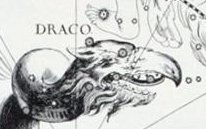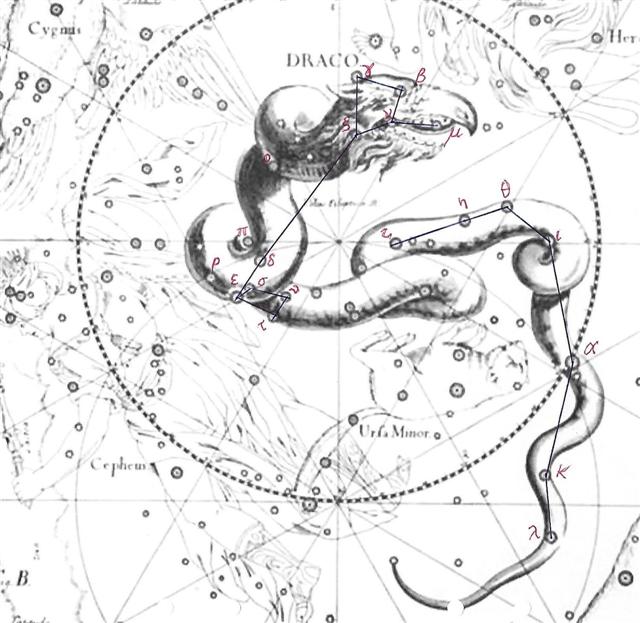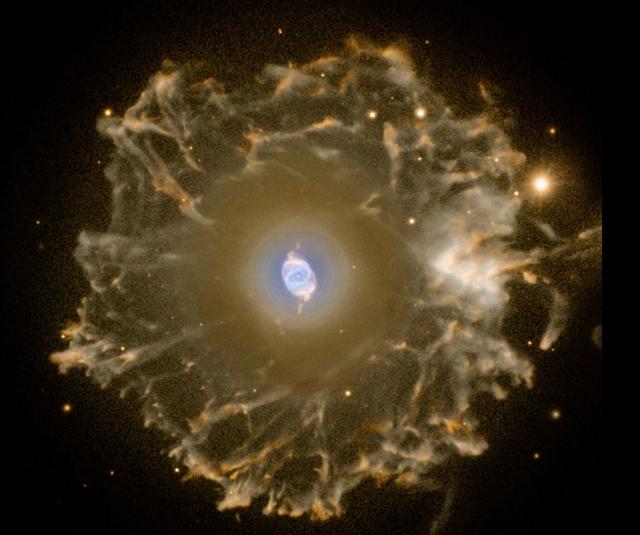
A tail marks an end and a head marks a
beginning. Heads and tails. The Dragon had his tail mark at
Thuban, the ancient Pole star. Once upon a time the tail of
the Dragon had risen heliacally in day 214 and at that
ancient time the mouth
orifice of
his (upside down?) head at Arrakis (μ,
the Little Shield) had been in day 260.
|
٭JULY
31 (212) |
 |
|
Ca2-1
(27) |
| Te
heke |
|
MUPHRID
(210.1), ζ Centauri (210.3) |
|
October
17 (290) |
|
NAKSHATRA DATES: |
|
٭JANUARY
29 (395 = 29 + 366) |
|
Al
Sharatain-1 /
Ashvini-1 /
Bond-16 /
Mahrū-sha-rishu-ku-1 |
|
Segin,
Mesarthim, ψ Phoenicis
(27.2),
SHERATAN,
φ Phoenicis (27.4) |
|
April 17
(473 = 107 + 366) |
|
٭AUGUST
1 |
2 (214) |
3 |
4 (*136) |
5 |
 |
 |
 |
 |
 |
|
Ca2-2 |
Ca2-3 |
Ca2-4 (30) |
Ca2-5 |
Ca2-6 |
|
erua tagata |
te
henua |
tagata oho ki tona huaga |
kua
oho |
|
φ
Centauri (211.0), υ¹ Centauri (211.1), υ² Centauri
(211.8), τ Virginis (211.9) |
Agena
(212.1), θ Apodis (212.5),
THUBAN
(212.8) |
14h
(213.1) |
Neck-2 |
Al
Ghafr-13 /
Svāti-15
TAHUA-TAATA-METUA-TE-TUPU-MAVAE |
|
π HYDRAE,
χ Centauri (213.0), Menkent (213.1) |
ASELLUS
TERTIUS,
κ
VIRGINIS,
14 Bootis (214.8) |
15
Bootis (215.2),
ARCTURUS
(215.4),
ASELLUS
SECUNDUS
(215.5),
SYRMA,
λ Bootis (215.6), η Apodis (215.8) |
|
October 18 |
19 |
20 |
21 |
22 (295) |
|
NAKSHATRA DATES: |
|
٭JANUARY
30 |
31 |
٭FEBRUARY
1 |
2 |
3 |
|
ι Arietis (28.0), λ
Arietis (28.2), υ Ceti (28.8) |
ALRISHA,
χ Phoenicis (29.2), Alamak (29.7) |
Arku-sha-rishu-ku-2 |
η Arietis (31.9) |
no star listed (32) |
|
2h
(30.4) |
|
κ Arietis (30.3),
HAMAL
(30.5)
ALKES
|
|
April 18 (108) |
19 (*29) |
*30 +
366 = *396 |
*214 + 183 = *397 |
22 |
|
Oho
1. To go: ka-oho! go! go away!
(i.e. 'goodbye' said by the person staying behind);
ka-oho-mai (very often contracted to:
koho-mai), welcome! (lit.: come here);
ku-oho-á te tagata, the man has gone. Ohoga,
travel, direction of a journey; ohoga-mai,
return. 2. Also rauoho, hair. Vanaga.
1. To delegate; rava oho,
to root. 2. To go, to keep on going, to walk, to
depart, to retire; ka oho, begone, good-bye;
oho amua, to preced; oho mai, to come,
to bring; oho arurua, to sail as consorts;
hakaoho, to send, a messenger. 3. Tehe oho te
ikapotu, to abut, adjoin; mei nei tehe i oho
mai ai inei te ikapotu, as far as, to; kai
oho, to abstain, to forego; hakaoho, to
put on the brakes. 4. The head (only in the
composite rauoho, hair). Churchill. |
|
٭AUGUST
6 |
7 |
8
(220) |
 |
 |
 |
|
Ca2-7 |
Ca2-8 |
Ca2-9 (35) |
|
manu rere |
e tara tua |
tagata oho |
|
ι
Lupi, 18 Bootis (216.3), Khambalia (216.4), υ
Virginis (216.5), ψ Centauri (216.6), ε Apodis
(216.8) |
ASELLUS PRIMUS
(217.8) |
τ
Lupi, δ Oct. (218.1), φ Virginis (218.7)
FOMALHAUT
|
|
October 23 |
24
(297) |
25 |
|
NAKSHATRA DATES: |
|
٭FEBRUARY
4 |
5 |
6 |
|
θ Arietis (33.3),
MIRA
(33.7) |
no star listed (34) |
ξ Arietis (35.0), ρ
Ceti (35.4), ξ² Ceti (35.9) |
|
April 23 |
24
(114) |
25 |
But at the time of Hyadum II the day numbers
had been 14 more, with Arrakis in OCTOBER 1 (274) and Thuban
in day 214 + 14 = 228 (AUGUST 16). 274 - 228 = 46 = 260 -
214.
|
oMARCH
16 |
17 |
18 |
19 (78) |
20 |
EQUINOX |
|
٭MARCH
18 |
19 (78) |
20 |
EQUINOX |
22 |
23 |
|
EQUINOX
(80) |
●MARCH
22 |
23 |
24 |
25 |
26 |
|
APRIL 1
(91) |
2 |
3 |
4 |
5 |
6 |
 |
 |
 |
 |
 |
 |
|
Ga1-11 |
Ga1-12 |
Ga1-13 |
Ga1-14 |
Ga1-15 |
Ga1-16 |
|
HAEDUS
II
(75.9) |
5h
(76.1) |
μ
AURIGAE, μ LEPORIS
(77.6) |
ĸ
Leporis (78.0),
RIGEL
(78.1), Flaming Star (78.2),
CAPELLA
(78.4), ο Columbae, τ Orionis (78.8)
THUBAN
|
λ
AURIGAE
(79.0),
λ LEPORIS
(79.6), ρ Aurigae (79.7)
ARCTURUS
|
Shur-narkabti-sha-iltanu-5 |
|
ε
Leporis (76.0),
CURSA
(76.4), λ Eridani (76.7) |
σ
Aurigae (80.4), Bellatrix, Saif al Jabbar (80.7),
ELNATH
(80.9) |
|
June 4 |
5 |
6 (157 =
314 / 2) |
7 |
8 |
9 (2 *
80) |
|
NAKSHATRA DATES: |
|
oSEPTEMBER 15 |
16 |
17 |
18 (261 = 9 * 29) |
19 |
20 |
|
٭SEPTEMBER
17 (260) |
18 |
19 |
20 |
21 |
EQUINOX |
|
●SEPTEMBER 20 |
21 |
EQUINOX |
23 (266) |
24 |
25 (*188) |
|
OCTOBER
1 |
2 |
3 |
4 (277) |
5 |
6 (*199) |
|
17h
(258.7) |
Mula-19 |
NODUS I
(260.0), π Herculis (260.7), Ras Algethi (260.8) |
SARIN
(261.0), ο Ophiuchi (261.4)
ALRISHA
|
ξ Ophiuchi (262.2), θ
Ophiuchi, ν Serpentis, ζ, ι Apodis (262.4), ι Arae
(262.8), ρ Herculis (262.9) |
β, γ Arae (263.3), κ
Arae (263.5), σ Ophiuchi (263.6) |
|
ARRAKIS
(258.7) |
Sabik (259.7), η
SCORPII (259.9) |
|
December 4 |
5 |
6 |
7 (*261) |
8 |
9 |
In the open mouth of the Dragon's head
was, I suggest, a sign (the Salver) which could have indicated the end of summer, 183
days after Haedus II in APRIL 1.
When King Hotu Matua came to Easter
Island his Queen Ava Rei Pua was onboard. The name Hotu
could
refer to the Full Moon and perhaps his
Queen therefore represented the complementary side of the
month, viz. New Moon - where a new month was created.
... When the
new moon appeared women assembled and bewailed those who had
died since the last one, uttering the following lament:
'Alas! O moon! Thou has returned to life, but our departed
beloved ones have not. Thou has bathed in the waiora a
Tane, and had thy life renewed, but there is no fount to
restore life to our departed ones. Alas
...
| Hotu
Ta.: hotu, to produce fruit,
Sa.: fotu, id. Mgv.: akahotu, the
September season. Churchill.
H.: Hoku, Night of the
full moon. When this moon set before daylight it was
called Hoku Palemo, Hoku that slips away.
When it set after daylight it was called Hoku Ili,
grounded Hoku. Ka mahina o Hoku, the full
moon of the night Hoku. Cf. hōkū, star. Hō
kū, star. (PPN fetu'u). Wehewehe. |
But according to Manuscript E the King had
another queen (or the same with another name) - viz.
Vakai. I cannot avoid associating this name with
vaha kai:
 |
|
vaha kai |
Vaha-kai may
have been shortened into Va-kai.
|
Kai
1. Ina kai;
verbal negation (but not used
with the imperative); ina kai
kai matou, we have not
eaten. 2. To eat; meal. 3.
Fruits or produces of the land,
vegetables, edible plants. 4.
Figuratively: he-kai ite
rogorogo, to recite the
inscriptions kohau rogorogo
(as spiritual food). 5.
Eclipse: ku-kai-á te raá, te
mahina, the sun, the moon
has been eaten (eclipsed).
Vanaga.
1. Negative;
kai rogo, to fast; kai
oho, to forego; kai maa,
to be ignorant, to doubt; vave kai kohe, inaccessible;
ina kai, see ina
1. Ta.: ai, no. 2. To
undergo, to suffer. 3. Sharp,
cutting. T Mgv.: koi, koikoi, pointed, sharp,
adapted for cutting; kokoi,
prickly, stinging, irritating.
Mq.: koi, sharp, cutting.
Ta.: oi, sharp, keen.
Since this is the only language
which has kai in this
sense the possibility of
typographical error should not
be overlooked. The form koi
outside of Southeast Polynesia
is found in Maori, Rarotonga and
Hawaii. 4. To eat, to feed, to
feast; food, meat, a meal,
repast; kai nui,
provision, intemperate,
voracious; kai no iti,
sober, temperate; hue ki te
kai, to victual; kai
taria te kai, abundance, to
abound; hakapee no kai hoao,
abundance, to abound. Kaia,
eaten. P Pau.: kai, food,
to eat. Mgv.: kai, food,
nourishment, to eat. Mq.: kai,
ai, food, to eat. Ta.: ai, to eat. 5.
Hakakai,
to take, to attack. Mgv.: kai,
to receive. Mq.: ai, to
catch some one, to seek to
surprise. Ta.: ai, to
receive, to get possession of,
to become master of. Churchill.
Kaihue,
a heap of food. Kaikino,
selfish, avaricious, faithless,
ingrate, miserly, rascal. Mq.:
kaikino, selfish, stingy, avaricious.
Kaipurua,
issue, outlet, egress. Kaitagata, cannibal;
paoa kaitagata, cannibal,
savage. Kaiu, nursling,
suckling. Pau.: kaiu, a
child at the breast. Mq.: kaiu, child at the breast,
unweaned, suckling, young of
animals. Ta.: aiu,
nursling. Churchill.
Pau.: Fakakai, earring. Ta.:
faaai, ear ornament. Mq.:
hakakai, id. Ma.: whakakai, id.
Kaikaia,
a league, a plot. Mgv.: kaia,
cruel, cannibal. Ta.: aiaa,
fault, sin. Mq.: kaia,
quarrelsome. Ma.: kaia,
to steal. Kaito, brave,
robust. Ta.: aito, brave.
Ma.: kaitoa, a brave man.
Kaitoa, well and good!
Ta.: aitoa, good! Ma.: kaitoa, id.
Kaitura,
bravery, manhood. Ta.: turatura, honored, exalted.
Churchill.
Mgv.: Kaiota, raw food. Ta.:
aiota, raw, ill cooked. Ma.:
kaiota, id. Churchill.
Ta.: Ai,
a bet, a wager, a game. Mq.: kai, to throw lots, to lose
a game. Sa.: 'ai, a count
toward the score of a game. Ma.:
kai, a puzzling toy. Aihamu, to eat leavings.
Mq.: kaihamu, id.
Churchill.
Mq.: Kaiheehee, to go from place
to place to enjoy feasts. Sa.:
'aisee, to beg food at
feasts. Kaihue, thief.
Ha.: aihue, to steal. Kaika, a meal, feast. Sa.:
'aiga, meal. Ha.: aina,
id. Kaioto, a sort of
hemorrhage, piles. Sa.: 'ailoto, a cancerous ulcer.
Kaitu, to perfume oneself
during a tabu period when it was
forbidden. Ha.: aiku, to
break a tabu. Churchill. |
AI,
v.
Haw., to
eat; s.
food,
vegetable
food, in
distinction
from ia,
meat; ai-na,
for ai-ana,
eating,
means of
eating,
fruits of
the land;
hence land,
field,
country. New
Zeal., kai, to
eat; kainga,
food, meal,
home,
residence,
country.
Tong., kai, to
eat. Sam.,
'ai,
to eat; ainga,
family,
kindred.
Marqu., kaika,
kainga,
food, meal.
Tagal., cain, to
eat.
Zend.,
gaya,
life; gaetha,
the world;
gava,
land,
country.
Vedic, gaya,
house,
family (A.
Pictet).
Sanskr., ghâsa,
food; ghas,
devour.
Greek, αία,
γαια,
γη,
different
forms
occurring in
Homer, land,
country,
cultivated
land;
γειος,
indigenous;
γειτων,
a neighbour;
ήια,
provisions
for a
journey.
Goth.,
gawi,
gauja,
country,
region.
Germ.,
gau.
Lat.,
ganea,
eating-house;
ganeo,
glutton.
Lith.,
goyas;
Ant. Slav.
and Russ.,
gai,
'past-rage',
nemus.
Polish,
gay,
id.
Mr. A.
Pictet, in
his 'Les
Origines
Indo-Europ.',
vol. II. p.
15, says
that the
Vedic and
Zend gay
'n'ont
surement
aucun
rapport avec
le grec γαια.'
This
assertion
evokes a
doubt,
inasmuch as,
as late a in
Homer's
time, two
other
dialectical
variations
of this word
existed in
the Greek,
viz. αία
and δα
or
δη,
in
δη-μητηρ,
contracted
from some
ancient form
in
δαια,
as
γη
and
γα,
from
γαια.
As neither
of these can
be supposed
to be
derived
from, or to
be a
phonetic
corruption
of, the
other, it
seems to me
that they
must have
come down
abreast from
primeval
times, thus
indicating
that the
original
root was
differently
pronounced
by various
sections of
the still
united Aryan
stock; and I
believe that
this root,
in its
archaic
forms, still
survives in
the
Polynesian
ai
and
kai,
to eat.
The Sanskrit
go,
land, the
earth, from
which Benfey
derives a
hypthetical
gavyd
and a Greek
γαfια
- by
elimination
γαια
- is
probably
itself a
contraction
from the
Vedic and
Zend
gaya,
as the Greek
γη
and
γα,
as the
ancient
Saxon
gâ
and
gô,
pagus,
regio, and
the ancient
Slav.
gai,
nemus, are
contractions
from
derivations
of that
ancient root
still found
in
Polynesia.
The above
derivatives
in sound and
sense
certainly
refer
themselves
better to
some ancient
ai
of
kai,
food, the
fruits of
the forest
or the roots
of the
field, than
to the
Sanskrit
go,
bull, cow,
cattle; for
the Aryan
family
undoubtedly
had one or
more names
for eating
and for food
before its
various
divisions
applied
themselves
to the
herding of
cattle. The
Sanskrit
ghas,
ghâsa,
the Latin
ganea,
ganeo,
point
strongly to
the
underlying
original
sense of
eating and
food.
According to
Professor A.
H. Sayce, in
'Introduction
to the
Science of
Language',
vol ii. p.
19, it is
probable
that the
Latin
edere,
to eat, is a
compound
word =
e-dere,
like
ab-dere,
con-dere,
cre-dere,
and others,
thus leaving
e
as the root.
How far that
e
may have
been a
dialectical
variant or a
phonetic
decay of an
older form
more nearly
allied to
the
Polynesian
ai,
kai,
I leave to
abler
philologists
to
determine.
(Fornander)
|


The Ecliptic Pole
lies close to where a line from
ζ to δ
would cross a line from χ to ξ. This
point seems to have been marked
under NGC 6543 (the Cat's Eye) in the chart below:


|
Thuban |
14h 04m 23.43s |
14h 04.391m |
213.8 |
|
NGC 6543 |
17h
58m 33.42s |
17h
58.557m |
273.2 |
|














